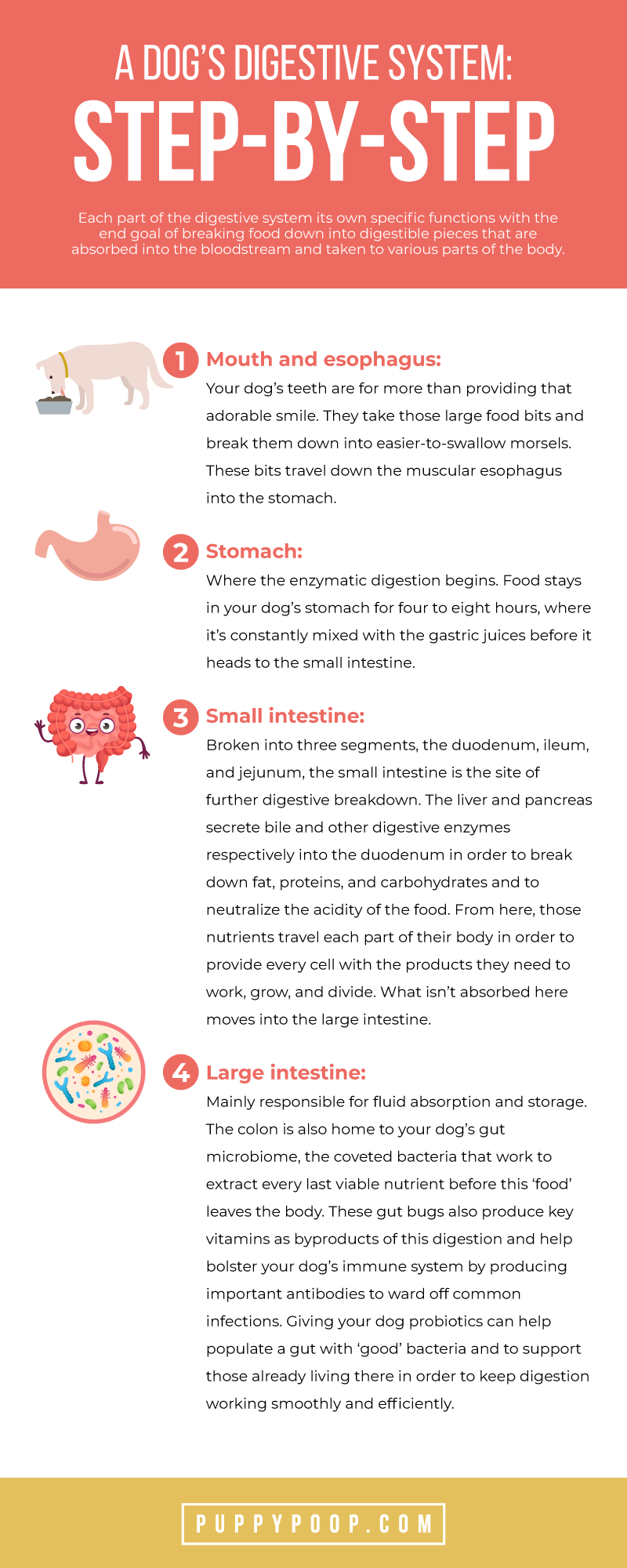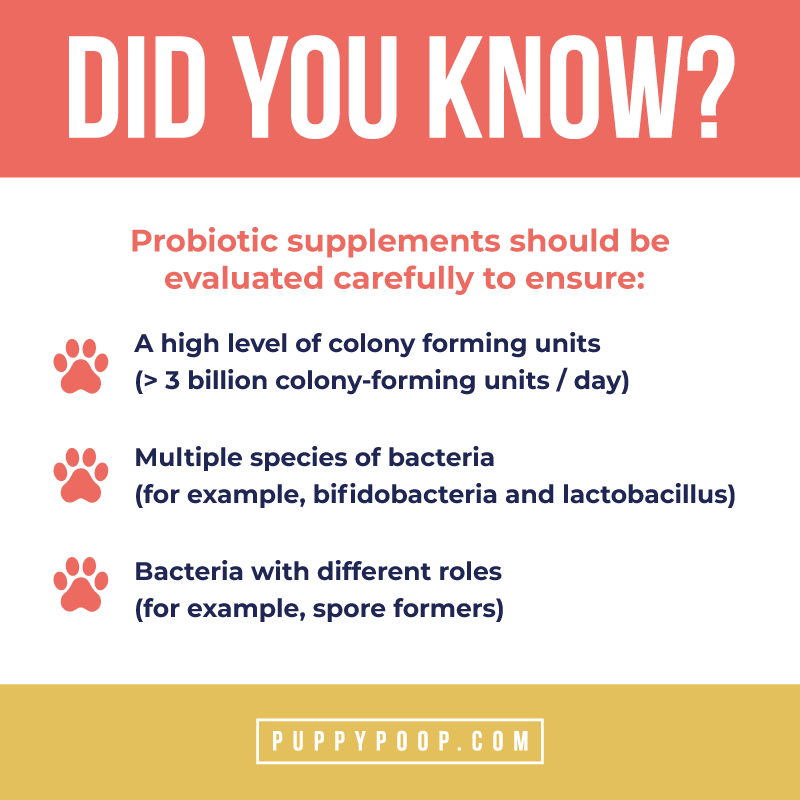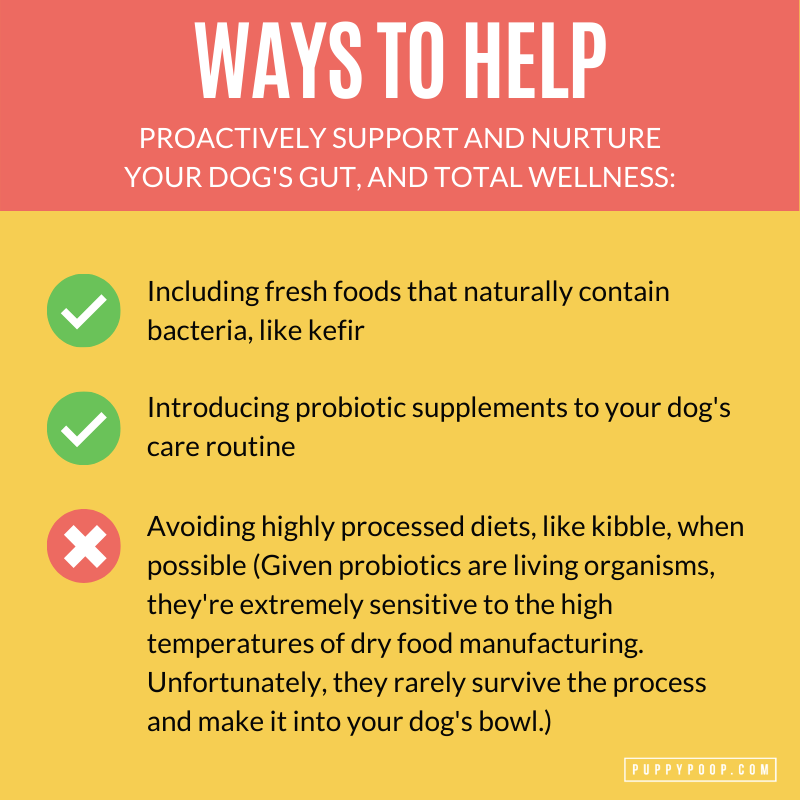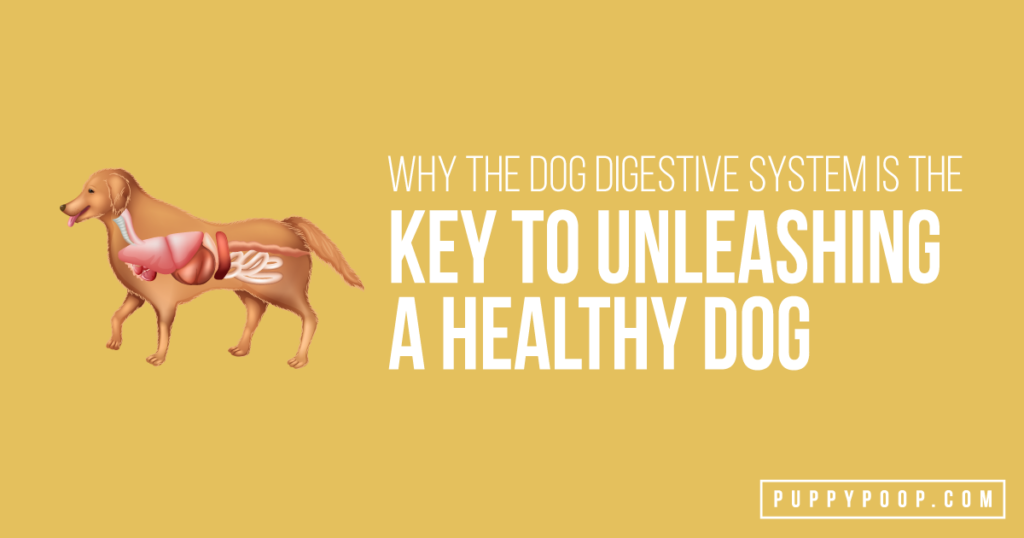We’ve heard that “the key to a man’s heart is through his stomach.” Well, the same can be said for our dogs. The dog digestive system is the key to all organ systems, even the heart, performing at their finest. The digestive system does more than just produce poop – it feeds the body, supplying nutrients like glucose and amino acids, to all cells and systems. Your dog’s heart wouldn’t beat, their tails wouldn’t wag, and their tongues wouldn’t loll without it. So, what does that all mean? It means the better that you nurture their gut health, the more your dog will thrive. Providing high quality nutrition directly impacts the health of your pup.
Let’s take a quick journey through a dog’s digestive system to learn how the food that we’re feeding helps or hinders their health, performance, and even happiness.
A Dog’s Digestive System: Step-By-Step
At its most basic, a dog’s digestive system is one long, continuous tube from the mouth to the rear end. However, what the digestive system does is anything but basic. Each part has its own special role in breaking down food into nutrients that are absorbed into the bloodstream and taken to various parts of the body.

Mouth and esophagus
Beyond phasing that handsome smile, your dog’s teeth are the first step in the digestive process. They take those large food bits and break them down into easier-to-swallow morsels. With the lubricative aid of saliva, these bits travel down the muscular esophagus into the stomach.
Stomach: The harsh environment in the stomach is where the enzymatic digestion begins. The stomach is thick-walled in order to protect itself from the acidic gastric juices that start the breakdown of food.
A dog’s stomach can reach a pH of 1.5, an acidity that’s capable of dissolving bone!
Food stays in a dog’s stomach for several hours, where it’s constantly mixed with the gastric juices before it heads to the small intestine.
Small intestine: This is where much of the magic happens for dog digestion and dog gut health. Both the liver and pancreas assist digestion by secreting bile and other digestive enzymes to break down fat, proteins, and carbohydrates. These fluids also help to reduce the acidity of the digested food. The reduced acidity coupled with the presence of rich nutrients allows special helpers to thrive. Trillions of bacteria and microorganisms, a dog’s gut microbiome, live in the small intestine. The small intestine contains the highest concentration of bacteria in the entire dog microbiome. The “good” bacteria, or probiotics, are extremely helpful – they actually assist in digestion by breaking down protein and fiber into essential vitamins and minerals that our dogs’ bodies can absorb. Each dog’s gut microbiome is extremely unique. The gut microbiome is affected by diet, exercise, genetics, age and other hygiene and environment factors. Over 70% of a dog’s immune system can be found in their digestive tract. In fact, the microbiome can help prevent the growth of disease causing pathogens like E. coli and Salmonella.
Since the average dog digests food much faster than a human (approx. 6–8 hours for dogs, compared to 24 for humans), it is important that there are ample probiotics to enable vital nutritional intake.
Now that the food is broken down, how does the dog absorb it? The small intestine is lined with a mucus coating that helps filter out germs while letting the nutrients pass through. The small intestine is lined with millions of finger-like projections called villi. These villi are responsible for moving these nutrient end products into the blood stream. Key nutrients travel through the bloodstream to where they’re needed: the brain, the eyes, the heart, the kidneys, everywhere, even to your dog’s tiniest paw pad. If a dog’s diet doesn’t provide these important nutrients, these cells won’t function properly.
Anything that hasn’t been absorbed continues its journey onward in the dog digestive system.
Large intestine: The large intestine, or colon, is responsible for fluid absorption and storage. The colon is also home to a portion of a dog’s gut microbiome. This is the last place along the GI tract that nutrients are absorbed. Finally, the remaining waste and undigested material moves through the rectum and through the anus into the world as poop. A dog’s poop can be a trove of valuable information and insights. Any variation in color, texture, frequency, or odor can alert you of any dog digestive issues. We encourage you to get familiar with your dog’s poop! It’s an easy way to help out your best friend.
Dog Digestion vs. Human Digestion – Surprising Differences
While we share a lot in common with our four-legged friends when it comes to digestion, there are a few notable differences to keep in mind to ensure your dog can live their best life!
- Shorter Digestion Time: Shorter Digestion Time: Food moves through a dog’s digestive system much faster than ours. The average dog digests food in 6–9 hours, compared with 20–30 hours for humans. Food may sit four to eight hours in the stomach alone, compared to only 30 minutes in humans. Surprisingly, it takes only a couple of hours to move through a dog’s intestines, compared to 20-30 hours in humans. This is also why your pup is more willing to settle for once or twice a day feeding with more frequent bowel movements. On the other hand, humans may crave constant snacks and daily bowel movements.
- Stomach Acidity: a dog’s stomach can reach a pH of 1.5, an acidity that’s capable of dissolving bone! It’s a tough environment for bacteria to survive in – good news for e.coli, but bad news for probiotics. That’s why it’s important to choose specific probiotics for your dog – strains that can withstand the extremely acidic stomach environment, to make it to the small intestine.
Dog Gut Health: Tips for Thriving
Here are some simple tips for avoiding some common dog digestive issues, and dog digestive problems remedies:
- Add probiotics: adding the “good” bacteria to your dog’s mealtime is a great way to keep those happy bugs in tip top shape, where they belong. Fresh sources of probiotics include fresh raw goat milk, kefir or kimchi. Probiotic supplements should be evaluated carefully to ensure a high level of colony forming units (> 3 billion colony-forming units / day), multiple species of bacteria (for example, bifidobacteria and lactobacillus), and bacteria with different roles (for example, spore formers).

- Avoiding highly processed diets, like kibble, as a sole source of nutrition: Feeding your dog fresh fruits, vegetables and proteins will nourish the microbiome and provide fresh sources of vitamins and minerals.
- Add natural fiber sources: Unsweetened canned pumpkin puree or psyllium husk are some easy fiber additions to ensure that the good bacteria are being nourished with their favorite foods!
- Count the Carbs: Baked treats can be filled with constipation-inducing carbs, like flour, oats, barley, and more. Try to swap biscuits for fresh, tasty treats from your refrigerator.

The dog digestive system is really where it’s going on in your dog’s body. It is what turns dog food into a walk in the park, a game of fetch, a healthy heartbeat and a fresh pile of poop. What you feed your dog’s digestion will determine how well the system thrives, and how healthy and happy your dog feels for years to come.
Get the DIG Labs App
Download the free DIG Labs Digestive Health Tracker to get personalized insights and recommendations for your dog based on their stool.

